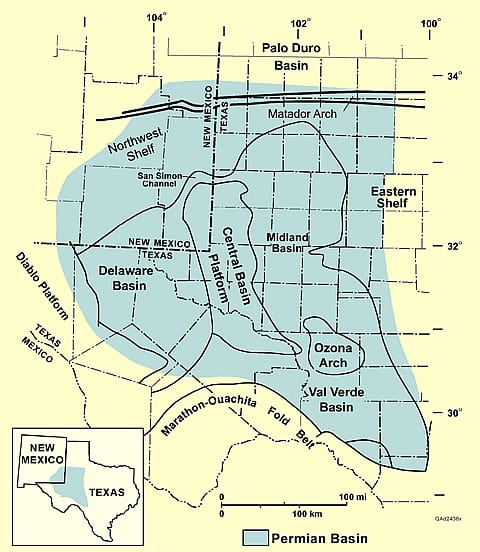The Permian Basin is a vast area covering West Texas and southeastern New Mexico. It has been known for decades as a region dripping with oil and gas reserves. Today, the Basin continues to produce, even as companies in other major shale regions fold under the pressures of low oil and gas prices.
It’s Huge
The Permian Basin stretches approximately 250 miles wide by 300 miles long, covering dozens of counties in Texas and New Mexico. One of the ten largest shale plays in the U.S., the Permian Basin produces a whopping 5 billion cubic feet of gas per day, plus 1.3 million barrels of oil per day.
It Isn’t Filled with Just Oil and Gas
The Permian Basin also holds large reserves of potash, which are salts that contain potassium in water-soluble form. Used in textile bleaching, glass making, and soap making, potash is most commonly used for manufacturing fertilizer. Most of the potash deposits along the Permian Basin lie in southeastern New Mexico in the Carlsbad Mining District.
First Commercially Drilled in 1920
On the surface, the Permian Area was covered in grasslands, which were inviting to farmers and ranchers who settled the area. In order to have adequate water supply for crops and livestock, landowners will drill for water, often discovering oil and gas along the way. In 1920, a discovery well was drilled in the Westbrook field of Mitchell County in West Texas. This well was successfully drilled to a depth of 2,498 feet, proving that oil and gas production from the Permian strata was viable.
Deep Drilling Came Later
Lack of infrastructure to move oil and gas to distant markets prevented deep drilling early on in the Permian Basin’s production. In 1928, a deep test at Big Lake oil field revealed ample resources at a depth of more than 8000 feet. Still, petroleum companies continued drilling at more economically feasible depths until the appropriate technology came along.
Fracking Has Been Instrumental to Deep Drilling
Over the past decade, drilling activity has boomed along the Permian Basin as hydraulic fracturing has enabled drillers to extract oil and gas from previously unreachable depths. Though a controversial practice, fracking has been key to unlocking deep drilling, greatly boosting local economies. Local land owners can lease or sell mineral rights to companies for a hefty sum, while the area as a whole benefits from increased sales tax revenues and more job opportunities.
It’s Been More Resilient in the Oil and Gas Downturn
In 2015, as oil and gas prices and stocks plummeted, things continued looking up for producers in the Permian Basin. The Wall Street Journal cites prolific wells and low costs as the reasons the Basin remains a viable area for production, while production in other shale plays has slowed to a trickle. Despite prices hovering around $40/barrel, companies like Pro Petro have been able to stay alive in a down market, thanks to their hefty investment in the Permian Basin.


